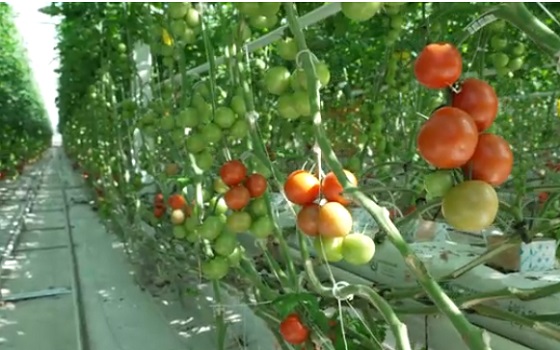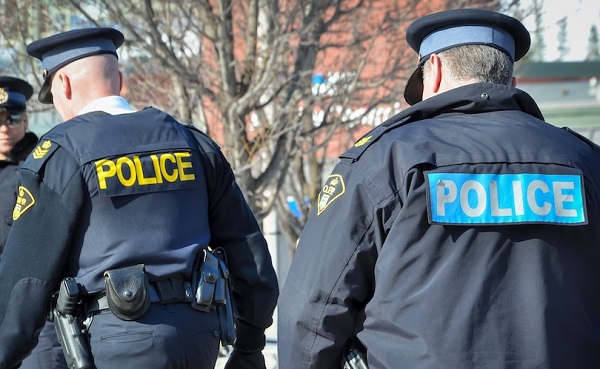Government of Alberta
Province investing to meet labour market demands by increasing access to “trades” education
From Government of AB
The province is providing more funding for scholarship programs for apprentices to meet labour market demands and increase access to trades education.

Lord Beaverbrook Grade 12 pipefitting student, Quinn Tubrett demonstrates welding skills to MLA R.J. Sigurdson from the Skilled Trades Task Force, Minister Nicolaides, Ray Massey, board chair of Skills Canada-Alberta and David LeMay, board member of CAREERS: The Next Generation.
Alberta is supporting high school students pursuing trades education by improving and increasing the scholarship program. The $1.5-million High School Apprenticeship Scholarship, which consolidates previous programs, will help more high school students access the education and training needed to get jobs in the trades.
“This investment will allow more young Albertans to access post-secondary education, through apprenticeship learning. We believe that a trades certificate has as much value, merit and worth as a university degree. When looking at post-secondary educational opportunities, I encourage young Albertans to give due consideration to the skilled trades. The trades provide a strong pathway to employment and to high-paying careers.”
“Our government has been working hard to strengthen the education system and support academic excellence and choice for our students as they prepare for their futures. These expanded scholarships will provide additional opportunities for Alberta high school students to pursue a career in the trades.”
“The High School Apprenticeship Scholarship will go a long way to recognize excellence and encourage our finest asset, Alberta’s youth, to continue their apprenticeship education and support them in their journey to reach their full potential as the future industry leaders on the world stage.”
“We are confident that the High School Apprenticeship Scholarship will be a valuable investment in the future of young Albertans, and ensure that they are able to pursue rewarding careers in the trades.”
“The High School Apprenticeship Scholarship is an important tool that recognizes that an apprenticeship is a valuable post-secondary education option and a career pathway that allows our young Albertans to achieve their own future career success as well as to become contributors to Alberta’s long-term economic prosperity.”
The province has injected an additional $1 million into the expanded program that recognizes the achievements of high school graduates who have chosen an apprenticeship pathway.
Qualified high school graduates in either the Registered Apprenticeship Program (RAP) or Career and Technology Studies (CTS) apprenticeship programs will receive a $1,000 scholarship. In addition, qualified graduates who have completed both a RAP and a CTS programs will receive a $2,000 Bright Future, High School Apprenticeship Scholarship.
Quick facts
- Over the past four years, an annual average of about 10,000 Alberta high school students in approximately 300 schools across the province participated in RAP and CTS classes.
- Over the last five years, an average of 344 recipients per year received the RAP/CTS Scholarship.
- More than 1,400 scholarships worth a total of nearly $1.5 million are being awarded for the 2019-20 school year:
- 1,387 High School Apprenticeship Scholarship awards valued at $1,000 each
- 35 High School Apprenticeship Scholarship – Bright Future awards valued at $2,000
- Over the next five years, nearly 20,000 skilled trades workers are expected to retire, with that number hitting more than 45,000 in 10 years. That’s equivalent to half the population of the City of Lethbridge leaving town.
Agriculture
Growing Alberta’s fresh food future

A new program funded by the Sustainable Canadian Agricultural Partnership will accelerate expansion in Alberta greenhouses and vertical farms.
Albertans want to keep their hard-earned money in the province and support producers by choosing locally grown, high-quality produce. The new three-year, $10-milllion Growing Greenhouses program aims to stimulate industry growth and provide fresh fruit and vegetables to Albertans throughout the year.
“Everything our ministry does is about ensuring Albertans have secure access to safe, high-quality food. We are continually working to build resilience and sustainability into our food production systems, increase opportunities for producers and processors, create jobs and feed Albertans. This new program will fund technologies that increase food production and improve energy efficiency.”
“Through this investment, we’re supporting Alberta’s growers and ensuring Canadians have access to fresh, locally-grown fruits and vegetables on grocery shelves year-round. This program strengthens local communities, drives innovation, and creates new opportunities for agricultural entrepreneurs, reinforcing Canada’s food system and economy.”
The Growing Greenhouses program supports the controlled environment agriculture sector with new construction or expansion improvements to existing greenhouses and vertical farms that produce food at a commercial scale. It also aligns with Alberta’s Buy Local initiative launched this year as consumers will be able to purchase more local produce all year-round.
The program was created in alignment with the needs identified by the greenhouse sector, with a goal to reduce seasonal import reliance entering fall, which increases fruit and vegetable prices.
“This program is a game-changer for Alberta’s greenhouse sector. By investing in expansion and innovation, we can grow more fresh produce year-round, reduce reliance on imports, and strengthen food security for Albertans. Our growers are ready to meet the demand with sustainable, locally grown vegetables and fruits, and this support ensures we can do so while creating new jobs and opportunities in communities across the province. We are very grateful to the Governments of Canada and Alberta for this investment in our sector and for working collaboratively with us.”
Sustainable Canadian Agricultural Partnership (Sustainable CAP)
Sustainable CAP is a five-year, $3.5-billion investment by federal, provincial and territorial governments to strengthen competitiveness, innovation and resiliency in Canada’s agriculture, agri-food and agri-based products sector. This includes $1 billion in federal programs and activities and $2.5 billion that is cost-shared 60 per cent federally and 40 per cent provincially/territorially for programs that are designed and delivered by provinces and territories.
Quick facts
- Alberta’s greenhouse sector ranks fourth in Canada:
- 195 greenhouses produce $145 million in produce and 60 per cent of them operate year-round.
- Greenhouse food production is growing by 6.2 per cent annually.
- Alberta imports $349 million in fresh produce annually.
- The program supports sector growth by investing in renewable and efficient energy systems, advanced lighting systems, energy-saving construction, and automation and robotics systems.
Related information
Alberta
Alberta introducing three “all-season resort areas” to provide more summer activities in Alberta’s mountain parks

Three iconic ski resorts to become summer hiking, mountain biking, zip-lining destinations.
Castle, Fortress and Nakiska have been designated as Alberta’s first all-season resort areas, making it easier for people to stay and play year-round.

For decades, red tape has restricted these resorts to winter operations and limited the ability to make facility upgrades or simply maintain existing facilities. These resorts are central to Alberta’s outdoor heritage, inspiring generations of athletes and outdoor enthusiasts. They have hosted world-class events such as the 1988 Olympics and served as the backdrop for cinematic blockbusters like The Revenant and Jumanji: The Next Level. All-season resort area designations support the revitalization of iconic resorts while maintaining strong environmental protections.
All-season resort areas will offer a wider variety of affordable and accessible recreation experiences for families, outdoor enthusiasts and visitors. These designations simplify regulatory processes while maintaining Alberta’s high environmental standards.
“Our government is proud to champion former Premier Peter Lougheed’s vision for Alberta’s Rockies, ensuring future generations can continue to access and enjoy these beautiful areas. By helping revitalize Alberta’s legendary ski resorts, we are striking the right balance of economic growth, environmental stewardship and Indigenous opportunity.”
Environmental excellence remains a core requirement. All projects must meet Alberta’s existing environmental standards, including the Public Lands Act, Water Act, and Environmental Protection and Enhancement Act, and will be subject to environmental assessment. Plans must address wildlife protection, water conservation, wildfire mitigation and sustainable visitor behaviour.
Since 2019, Alberta has expanded provincial parks and recreation areas by more than 300,000 hectares. As part of these designations, minor boundary adjustments ensure long-standing ski terrain is placed under the appropriate regulator, affecting less than 0.03 per cent of Alberta’s parks system.
“All-season destinations are all about serving community and building community. The new all-season policy will bring both social and economic opportunities to Alberta.”
Over the next decade, these three all-season resort areas have the potential to create 24,000 new jobs, $3.6 billion in GDP, and $4 billion in visitor spending. All-season resort developers and operators will be encouraged to partner with local businesses and use locally sourced materials, workforce talent, suppliers and service providers.
“Alberta’s outdoor recreation and resort potential was held back for decades by an unworkable land-use framework, even as our population grew. The new all-season resort regulations will now help catalyze responsible, year-round, nature-based development that draws new rural investment and strengthens Alberta’s culture of stewardship through lived connections with the land.”
All-season resorts present the opportunity to further support Indigenous economic participation, leadership and cultural inclusion in Alberta’s visitor economy. Alberta’s government is committed to continuing meaningful engagement with Indigenous communities, including ensuring that Treaty rights and traditional practices are respected.
To foster trust, transparency and collaboration in the development and management of all-season resorts, Indigenous groups were formally consulted by Alberta’s government as part of designation evaluations. Prospective project proponents must undertake consultations in accordance with Government of Alberta consultation policies and guidelines.
“Alberta’s first all-season resort areas mark an important step forward, and we are encouraged by the ongoing engagement between our Nations and proponents. When development respects our land and is built on true partnership with our communities, it creates meaningful opportunities for Indigenous Peoples, supporting economic growth, strengthening leadership and sharing our culture with visitors.”
“We look forward to working with the province to make sure that Treaty rights are upheld, protect the land and maintain open dialogue with our communities as these resorts move forward, ensuring Indigenous Peoples play a leading role in shaping Alberta’s visitor economy for generations to come.”
“The All-Seasons Resort Act presents a significant opportunity for meaningful Indigenous economic participation in the tourism sector. By capitalizing on this potential, Indigenous tourism can propel Alberta’s tourism sector to become a national leader and serve as a tangible tool for economic reconciliation, including job creation, language revitalization and cultural pride.”
Alberta’s government has created a clear regulatory pathway for all-season resorts. Designation is the first step in the regulatory process. Prospective project proponents can now begin Indigenous consultation, public engagement and proposal submissions to the regulator. Each proposal will be carefully reviewed by the regulator with input from subject matter experts and affected municipalities.
Revitalizing Alberta’s iconic ski resorts – STAKEHOLDER QUOTES
“Alberta’s outdoor recreation and resort potential was held back for decades by an unworkable land-use framework, even as our population grew. The new all-season resort regulations will now help catalyze responsible, year-round, nature-based development that draws new rural investment and strengthens Alberta’s culture of stewardship through lived connections with the land.”
“The All-Seasons Resort Act is exciting news for Alberta’s tourism sector. We welcome the clarity it gives to plan for the future of Kananaskis. We look forward to working with our partners and the province to support sustainable, year-round growth in a way that benefits our communities and protects what makes this place so special.”
“The All-Seasons Resort Act presents a significant opportunity for meaningful Indigenous economic participation in the tourism sector. By capitalizing on this potential, Indigenous tourism can propel Alberta’s tourism sector to become a national leader and serve as a tangible tool for economic reconciliation, including job creation, language revitalization and cultural pride.”
“All-season destinations are all about serving community and building community. The new all-season policy will bring both social and economic opportunities to Alberta.”
“Alberta’s first all-season resort areas mark an important step forward, and we are encouraged by the ongoing engagement between our Nations and proponents. When development respects our land and is built on true partnership with our communities, it creates meaningful opportunities for Indigenous Peoples, supporting economic growth, strengthening leadership and sharing our culture with visitors.”
“We look forward to working with the province to make sure that Treaty rights are upheld, protect the land and maintain open dialogue with our communities as these resorts move forward, ensuring Indigenous Peoples play a leading role in shaping Alberta’s visitor economy for generations to come.”
“Alberta Municipalities appreciates the provincial government’s commitment to municipal collaboration with the new All Season Resort Policy. Early consultation with municipalities results in stronger partnerships and better regional decisions that benefit Albertans.”
“AIOC welcomes the Government of Alberta’s leadership in ensuring Indigenous Nations and groups are engaged early in all-season tourism development. That approach supports reconciliation through responsible land stewardship, and long-term economic prosperity. With our expanded mandate, AIOC is ready to advance Indigenous-led tourism projects that drive investment and sustainable growth across the province.”
-

 Agriculture1 day ago
Agriculture1 day agoWhy is Canada paying for dairy ‘losses’ during a boom?
-

 Automotive2 days ago
Automotive2 days agoFord’s EV Fiasco Fallout Hits Hard
-

 Alberta1 day ago
Alberta1 day agoAlberta’s new diagnostic policy appears to meet standard for Canada Health Act compliance
-

 Business14 hours ago
Business14 hours agoState of the Canadian Economy: Number of publicly listed companies in Canada down 32.7% since 2010
-

 Censorship Industrial Complex12 hours ago
Censorship Industrial Complex12 hours agoCanadian university censors free speech advocate who spoke out against Indigenous ‘mass grave’ hoax
-

 Alberta15 hours ago
Alberta15 hours agoHousing in Calgary and Edmonton remains expensive but more affordable than other cities
-

 Bruce Dowbiggin16 hours ago
Bruce Dowbiggin16 hours agoHunting Poilievre Covers For Upcoming Demographic Collapse After Boomers
-

 Censorship Industrial Complex1 day ago
Censorship Industrial Complex1 day agoTop constitutional lawyer warns against Liberal bills that could turn Canada into ‘police state’






